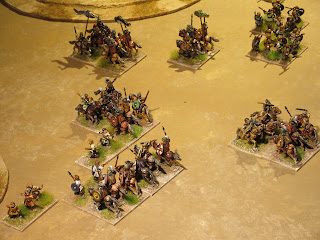Leaving Roman Gaul in 409, the great migration of Vandals, Suevi and Alani crossed the Pyrenees and entered Hispania. They met little
resistance as troops were busy fighting in external conflicts
leaving the Germanic tribes free to find locations to settle in. A century later, the Suevi had firm control over the northwest part of Hispania that would later become
Galicia. It was here that the Visigoths would meet stiff resistance.
According to the DBA rule book, the Suevi count 'forest' and later 'arable' terrain as homeland geography. That would be changed to 'hilly' to reflect the landscape characteristic of Galicia. The Suevi may have the Greuthingi as allies, but it is doubted
such interaction last into the 6th century however, not all the Alani joined the Vandals in crossing into Africa; some did settle in Lusitania and for this series
of test games, the Alani substitute for the Greuthingi as allies.
Game 1
The Suevi, seen on the left of the photo, have both
flanks resting on woods. Suevi two wings with the infantry on the right and the cavalry
and allies forming the left. The left wing are supported by Suevi archers. Opposite them the Visigoths
have deployed their troops to mirror the Suevi deployment with their formidable
cavalry making up half their number.
Both armies keep pace with their infantry keeping the appearance of an unbroken line. Suevi archers have deployed at the edge of the wood.
The shock of the two lines meeting reverberates across
the battlefield and it is not long before Visigothic cavalry are sent recoiling from
archery fire. The effect of the archers and Suevi cavalry is immediately felt, (2 – 0).
The crucial moment came when the Suevi general caught
his counterpart in the flank bringing their commander down. Seeing the Draco
standard fall, the Visigoths lost heart and fled the field. Score 4g – 0 for the Suevi.
Game 2
The Suevi now had the advantage of ground and so
placed their infantry to secure both hills leaving the cavalry to deploy on the
valley floor. The Visigoths deployed in a similar manner as in their previous
battle; two wings, one of cavalry and the other of infantry.
To counter the Suevic archers positioned on the hill,
the Visigoths sent their skirmishers to deal with them. This manoeuvre required some
time forcing the Visigothic battle line to move slowly forward. The Suevi
viewed this as timidity on the part of the Visigoths and so moved off their
defensive position.
As the battle lines came together, the Visigothic
skirmishers were countered by Suevic skirmishers leaving the Suevic archers
free to find other targets.
In the ensuing battle, lines broke as both sides
forced their opponents to recoil. Here, the Suevic infantry bested their opposition
earning them a narrow victory. Score 4 –
3 for the Suevi.
Game 3
The battlefield for the final engagement offered both
sides the protection of each army’s left flank; however, the Visigoths would be
wary of the hill opposite their right as this would become an ideal position
for Suevic archers.
To counter that threat, Visigothic skirmishers were
sent to clear the hill of the archers. During this time, the Visigothic cavalry would need
to wait patiently before moving forward. The Suevi noticing the delay moved
their infantry forward to seize the occupied hill nearest the lake.
The attempt by the Visigothic skirmishers to clear the
hill failed leaving the Visigothic commander no option but to risk an all out assault
before the Suevic archers could regroup. Visigothic infantry moved off their
hill position to support their cavalry assault.
The situation heated up as both of the Suevic allied
cavalry fell bringing the score even. Suevic infantry were able to form a line
in front of the Visigothic cavalry.
Visigothic cavalry however, were able to break up the Suevic
battleline and together with the Visigothic infantry created enough casualties
to earn a victory. The final blow came when the Suevic commander fell making
this into a decisive victory for the Visigoths. Score
7g – 3 for the Later Visigoths.
Note:
For the selection of terrain pieces we used the Random Terrain Generator
which can be found at the Fanaticus Forum.














Nice looking battles once more!
ReplyDeleteThank you Phil,
ReplyDeleteThe majority of Dark Age armies share the same weaponry, armour and in many cases the same style of clothing. Keeping them distinct from each other is one of the toughest aspects of painting these armies.
Cheers,